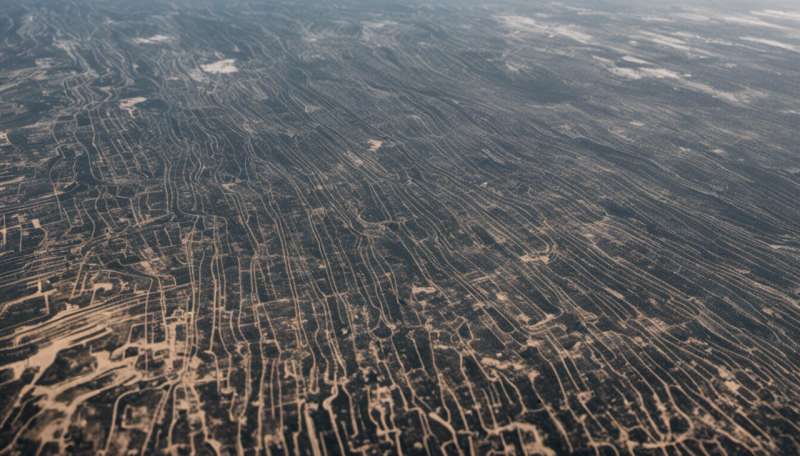Credit: AI-generated image (disclaimer)
(Phys.org) —Recently, Beijing and the nearby Chinese provinces were veiled in smog that reduced visibility, induced health problems, and reached levels described as "beyond index."
Last week, a team of scientists, which included Argonne's David Streets, a senior energy and environmental policy scientist, published research showing that several different air pollutants from China reach the shores of the western United States. The Chinese-led international research team found that the export of air pollution is tied directly to China's production of consumer goods for export to the United States, creating a complex web of economic and environmental problems.
Although China received most of the media spotlight, other countries also add increasing amounts of pollution into the atmosphere.
Late last year, Argonne researcher Zifeng Lu, Streets, and scientists from Saint Louis University and NASA's Goddard Space Flight Center analyzed satellite data of sulfur dioxide (SO2) emissions in India, which recently brought online many coal-fired plants. The researchers found a steady increase of SO2 emissions across India, in contrast to Indian government reports implying that the rates had been declining. The newly discovered increase of 60 percent from 2005 to 2012 shifted India into the No. 2 slot of biggest emitter of SO2, after China, as the U.S. dropped into the No. 3 spot. Without the analysis of satellite data, the increase might have continued to escape notice. The Indian government used ground-based pollution monitors located near cities rather than close to plants. Their most recent published data was also from 2008.
"Scientific research like this, using advanced technological instrumentation, provides a sound basis for designing more effective environmental control policies," Streets said. For example, in India, all newly constructed coal-fired plants have been required to reserve floor space for air pollution mitigation technology, although at the time of construction the devices were not installed.
Argonne researchers like Streets are part of an endeavor that tracks emissions from around the world to assess the impact of human activities on the atmosphere, particularly in the generation and use of energy. Air pollution involves many different compounds. The U.S. government actively tracks several, including particulate matter like black carbon, ozone, sulfur dioxide, carbon monoxide, and nitrogen dioxide, and contributes to government recordkeeping of air pollution inventories.
Keeping tabs on air pollution involves an understanding of a myriad of factors: how many pollutants are produced, where, when, how long they persist in the environment, how long they remain detectable, where they end up, and how different sources of pollution combine. The most useful data is collected frequently enough to be effective in shaping policies and making predictions.
The research in India, for example, was able to compile a year-to-year view of events using satellite data. With more complete and recent data, the researchers not only discovered the overall increase of SO2, but were also able to make a specific recommendation: move the monitors closer to the plants where chemicals can be detected before they dissipate. Elevated SO2 can only be identified within about 30 miles of the factory. Beyond that distance, the SO2 persists, but the signal-to-noise ratio is too high to detect its presence.
Streets and his coworkers are working to get the most out of satellite data. By using several passes of satellite data coverage, they can re-aggregate the pixels of information, and go from low- to high-resolution images.
Downloading data of daily satellite passes permits more recent glimpses of events than the infrequent processing of monitors located on the ground. Ground monitors are sparsely distributed and expensive to maintain compared to satellite surveillance from space.
Streets is also interested in using data to show how sources of pollution combine—whether from power plants, cities, or oil and gas drilling sites.
In the future, Argonne researchers plan to apply their new techniques to refine views of air pollution in the United States. "The aim," Streets said, "is to provide new algorithms and datasets to give regulators better information to go on." The improved emissions data also allows for more accurate predictions and improved performance of climate models.
The potential to affect positive change at home and abroad is great. The recent study on the export of Chinese air pollution stated that Chinese emissions could be dramatically reduced if China enhanced energy efficiency and deployed emission control technologies similar to those used in the United States.
Streets said, "This work is part of a new initiative on the part of NASA's AQAST (Air Quality Applied Sciences Team), with the laudatory goal of helping to make sophisticated satellite datasets more useful in air quality management."
More information: "China's international trade and air pollution in the United States." Jintai Lin, Da Pan, Steven J. Davis, Qiang Zhang, Kebin He, Can Wang, David G. Streets, Donald J. Wuebbles, and Dabo Guan. PNAS 2014 ; published ahead of print January 21, 2014, DOI: 10.1073/pnas.1312860111
"Ozone Monitoring Instrument Observations of Interannual Increases in SO2 Emissions from Indian Coal-Fired Power Plants during 2005–2012." Zifeng Lu, David G. Streets, Benjamin de Foy, and Nickolay A. Krotkov. Environmental Science & Technology 2013 47 (24), 13993-14000. DOI: 10.1021/es4039648
Journal information: Proceedings of the National Academy of Sciences , Environmental Science & Technology
Provided by Argonne National Laboratory
























